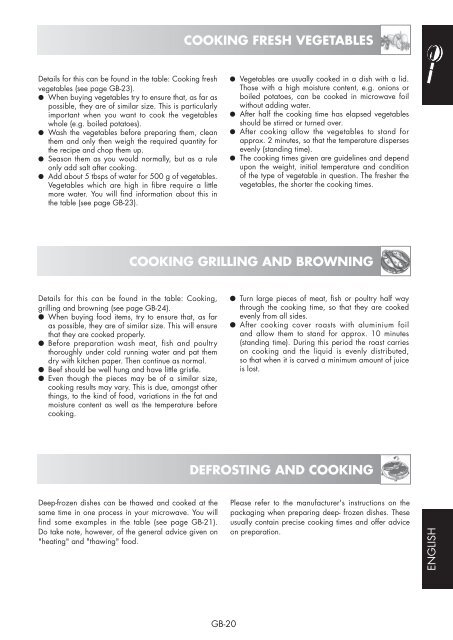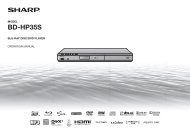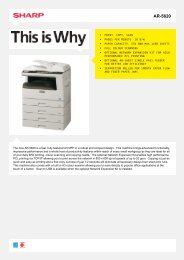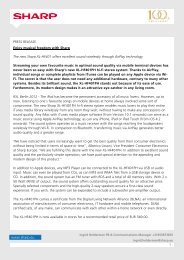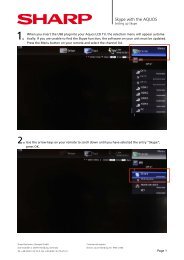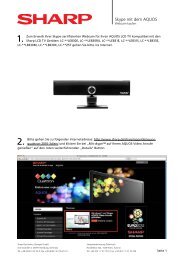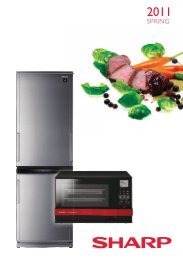R-667-A Operation-Manual GB - Sharp
R-667-A Operation-Manual GB - Sharp
R-667-A Operation-Manual GB - Sharp
Create successful ePaper yourself
Turn your PDF publications into a flip-book with our unique Google optimized e-Paper software.
COOKING FRESH VEGETABLES<br />
Details for this can be found in the table: Cooking fresh<br />
vegetables (see page <strong>GB</strong>-23).<br />
● When buying vegetables try to ensure that, as far as<br />
possible, they are of similar size. This is particularly<br />
important when you want to cook the vegetables<br />
whole (e.g. boiled potatoes).<br />
● Wash the vegetables before preparing them, clean<br />
them and only then weigh the required quantity for<br />
the recipe and chop them up.<br />
● Season them as you would normally, but as a rule<br />
only add salt after cooking.<br />
● Add about 5 tbsps of water for 500 g of vegetables.<br />
Vegetables which are high in fibre require a little<br />
more water. You will find information about this in<br />
the table (see page <strong>GB</strong>-23).<br />
● Vegetables are usually cooked in a dish with a lid.<br />
Those with a high moisture content, e.g. onions or<br />
boiled potatoes, can be cooked in microwave foil<br />
without adding water.<br />
● After half the cooking time has elapsed vegetables<br />
should be stirred or turned over.<br />
● After cooking allow the vegetables to stand for<br />
approx. 2 minutes, so that the temperature disperses<br />
evenly (standing time).<br />
● The cooking times given are guidelines and depend<br />
upon the weight, initial temperature and condition<br />
of the type of vegetable in question. The fresher the<br />
vegetables, the shorter the cooking times.<br />
COOKING GRILLING AND BROWNING<br />
Details for this can be found in the table: Cooking,<br />
grilling and browning (see page <strong>GB</strong>-24).<br />
● When buying food items, try to ensure that, as far<br />
as possible, they are of similar size. This will ensure<br />
that they are cooked properly.<br />
● Before preparation wash meat, fish and poultry<br />
thoroughly under cold running water and pat them<br />
dry with kitchen paper. Then continue as normal.<br />
● Beef should be well hung and have little gristle.<br />
● Even though the pieces may be of a similar size,<br />
cooking results may vary. This is due, amongst other<br />
things, to the kind of food, variations in the fat and<br />
moisture content as well as the temperature before<br />
cooking.<br />
● Turn large pieces of meat, fish or poultry half way<br />
through the cooking time, so that they are cooked<br />
evenly from all sides.<br />
● After cooking cover roasts with aluminium foil<br />
and allow them to stand for approx. 10 minutes<br />
(standing time). During this period the roast carries<br />
on cooking and the liquid is evenly distributed,<br />
so that when it is carved a minimum amount of juice<br />
is lost.<br />
DEFROSTING AND COOKING<br />
Deep-frozen dishes can be thawed and cooked at the<br />
same time in one process in your microwave. You will<br />
find some examples in the table (see page <strong>GB</strong>-21).<br />
Do take note, however, of the general advice given on<br />
"heating" and "thawing" food.<br />
Please refer to the manufacturer's instructions on the<br />
packaging when preparing deep- frozen dishes. These<br />
usually contain precise cooking times and offer advice<br />
on preparation.<br />
ENGLISH<br />
<strong>GB</strong>-20<br />
R-<strong>667</strong>_[EN ckbk].indd <strong>GB</strong>-20<br />
6/2/09 3:02:00 PM


